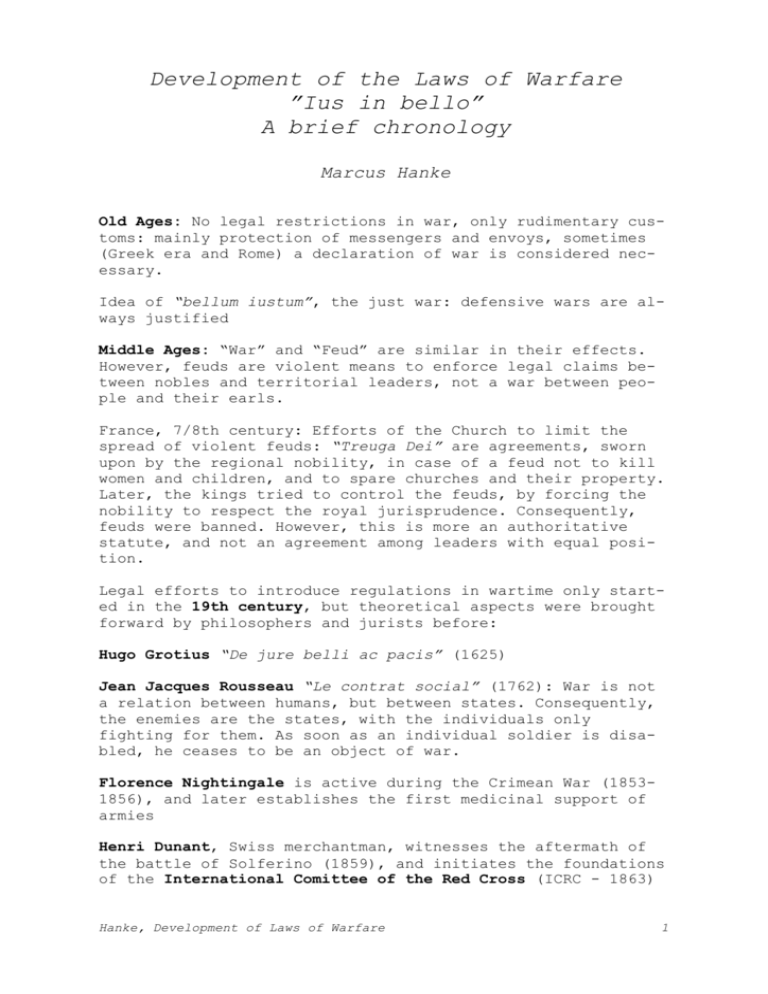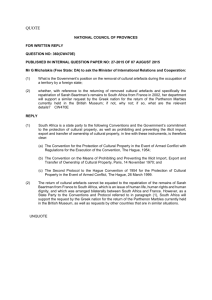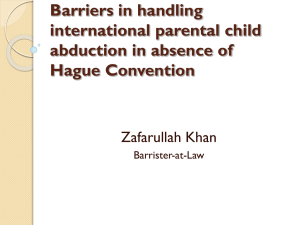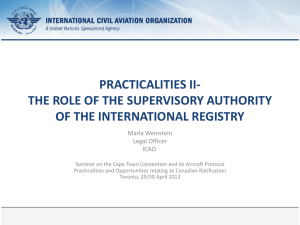Development of the Laws of Warfare
advertisement

Development of the Laws of Warfare ”Ius in bello” A brief chronology Marcus Hanke Old Ages: No legal restrictions in war, only rudimentary customs: mainly protection of messengers and envoys, sometimes (Greek era and Rome) a declaration of war is considered necessary. Idea of “bellum iustum”, the just war: defensive wars are always justified Middle Ages: “War” and “Feud” are similar in their effects. However, feuds are violent means to enforce legal claims between nobles and territorial leaders, not a war between people and their earls. France, 7/8th century: Efforts of the Church to limit the spread of violent feuds: “Treuga Dei” are agreements, sworn upon by the regional nobility, in case of a feud not to kill women and children, and to spare churches and their property. Later, the kings tried to control the feuds, by forcing the nobility to respect the royal jurisprudence. Consequently, feuds were banned. However, this is more an authoritative statute, and not an agreement among leaders with equal position. Legal efforts to introduce regulations in wartime only started in the 19th century, but theoretical aspects were brought forward by philosophers and jurists before: Hugo Grotius “De jure belli ac pacis” (1625) Jean Jacques Rousseau “Le contrat social” (1762): War is not a relation between humans, but between states. Consequently, the enemies are the states, with the individuals only fighting for them. As soon as an individual soldier is disabled, he ceases to be an object of war. Florence Nightingale is active during the Crimean War (18531856), and later establishes the first medicinal support of armies Henri Dunant, Swiss merchantman, witnesses the aftermath of the battle of Solferino (1859), and initiates the foundations of the International Comittee of the Red Cross (ICRC - 1863) Hanke, Development of Laws of Warfare 1 in Geneva Francis Lieber drafts the first set of rules to be respected in the American Civil War (Lieber Code - 1861) First Geneva Convention for the protection of wounded and sick in the war on land (1864): Initiated by the ICRC, it is the first step towards what later is called “Geneva law” Saint Petersburg Declaration, renouncing the use, in time of war, of Explosive Projectiles under 400 grammes weight (1868): The first treaty in international law that incorporates Rousseau’s thoughts about war being a status between states, not between people: “... that the only legitimate object which states should endeavour to accomplish during war is to weaken the military forces of the enemy; That for this purpose it is sufficient to disable the greatest possible number of men; That this object would be exceeded by the employment of arms which uselessly aggravate the sufferings of disabled men, or render their death inevitable; That the employment of such arms would, therefore, be contrary to the laws of humanity;” Hague Declaration (1874): Set of rules, similar to the Lieber code, that itself was never ratified as international treaty, but influenced the development of the laws of warfare. Many of its provisions were adopted in the 1880 Oxford Manual, a drafted handbook on laws and customs in war. (First) Hague peace conference and Hague Convention respecting laws and customs of war on land (1899 and 1907): Initiated by Russia, the first Hague peace conference in 1899 was the first international conference, successful in codifying a comprehensive set of rules governing the law of land warfare. However, the convention was limited in its application by the “general participation clause” (Art. 2), which provided the application of the convention only in conflicts in which all participants are also parties to the convention. Besides that, the Hague convention specifically referred to the customary law, as “usages established among civilized people” Unfortunately, the future prospects of a possible aerial warfare only resulted in a declaration banning the drop of bombs from balloons, which was limited to five years. In 1907, the second Hague peace conference resulted in an even more comprehensive catalogue of treaties, besides the convention on land warfare (Convention IV), for example: Hanke, Development of Laws of Warfare 2 Hague Convention V about the rights and obligations of neutrals in land war; Hague Convention VII about the conversion of merchant ships into warships; Hague Convention IX about the bombardment by naval forces; Hague Convention XIII about neutrals in naval warfare. The efforts for a renewal of the ban of dropping bombs from balloons were fruitless. Instead, a single sentence was changed in the Hague Convention IV’s provision of bombing besieged cities, in order to include aerial attacks. The First World War (1914-18) brought a new scope of mechanized warfare, with machine guns, submarines, mines, poison gas and strategic air warfare. Most of the Hague law, in spite of being rather freshly adopted, proved to be obsolete. Consequently, first efforts to remedy the situation were made shortly after the war: Hague Commission of Jurists (1922/23) and Hague rules of air warfare: Complete set of rules, drafted by lawyers together with military experts. They were widely discussed and influenced the practice of the military and the diplomats, but they were never adopted as formal treaty law. The only other efforts of improving the laws of war in this time: Geneva protocol for the prohibition of the use in war of asphyxiating, poisonous or other gases, and of bacteriological means of warfare (1925): This convention did not ban the production and stocking of poison gas, only its use. Geneva convention relative to the treatment of prisoners of War (1929): This convention became very important during World War II. The states efforts shifted from a codification of the laws of war towards a complete ban of war. Consequently, the study of ius in bello was considered against the logic and counterproductive. Foundation of the League of Nations (1920) as a means of collective security; Kellogg-Briand pact to ban the war as means of international policy (1928); Geneva Disarmament Conference (1932-34), ended without results. Hanke, Development of Laws of Warfare 3 The Second World War (1939-45) brought another dimension of warfare, with genocide (the Holocaust), massive strategic warfare in the air and nuclear weapons. The lack of codification efforts between the wars proved disastrous, only the rights of prisoners of war were generally respected, although with many breaches. Directly after WW II, the ICRC initiated massive efforts for a codification: Four Geneva Conventions (1949): No. 1 dealing with the fate of wounded and sick soldiers in the field; No. 2 wounded and sick at sea; No. 3 prisoners of war; No. 4 civilian population in times of war. Several problematic issues were not touched (air warfare, nuclear weapons). Hague Protocol for the protection of cultural property in the event of armed conflict (1954): possibility to designate individual buildings, or whole zones as protected curltural property already in peace time. The shortcomings of the Geneva Conventions result in the two Additional Geneva Protocols (1977): No. 1: international conflicts No 2: non-international conflicts The two protocols suffer from their strict outruling of several sensitive topics: they ban reprisals, allow freedom fighters without uniforms as combatants and ban nucelar weapons (although not literally). Consequently, some of the major nations still have not ratified them. Further codifications about specific means of warfare: UN Convention on prohibitions or restrictions on the use of certain conventional weapons which my be deemed to excessively injurous or to have indiscriminate effects (1980): Protocol 1: non-detectable fragments Protocol 2: mines and booby-traps Protocol 3: incendiary weapons Protocol 4 (1995): blinding laser weapons Ottawa Convention on the prohibition of the use, stockpiling, production and transfer of anti-personnel mines and on their destruction (1997) Hanke, Development of Laws of Warfare 4






